Ski report from Kårsavagge, March 2002.
If you want the background to these stories, see the introduction.
I hadn't been on a hut-to-hut tour for 4 years, mostly out of fear
for developing tendonitis far from civilisation. My hands had swollen up and
been useless for a week the last time, but luckily I was only at Kebnekaise
fjällstation when it happened. But I miss the huts, so this year I decided
to compromise and ski one day out from Abisko to Kårsavagge and then
do day trips from there. Kårsavagge is not on
a recognised through-trail and scooters are forbidden in the area, so it would
probably be empty except for me and the wardens (there were a total of
9 visitors in March 2000 when scooters were allowed), and that was just what I needed.
Life had been rather stressful recently, which meant that it had been hard
to plan the trip, but that I needed it all the more.
Even on the train up I couldn't get my mind into the trip, and for once I met no
fellow skiers that I recognised.
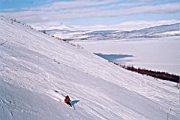
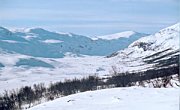 I arrived in Abisko to a beautiful, still, cloudless day at -5°C, and
after dumping my packs in my room I headed straight for the house
ski slope, Nuolja. Actually, it's just a lift, which deposits you on the
ungroomed face of the mountain, 500m above the fjällstation.
Because I was planning mostly top-tours, I had left my regular tour skis
at home, and was on Tua Cirques, which have a soft camber and a distinct waist,
and I wore heavier leather boots with double straps.
This was a great combination for telemarking down Nuolja's offpiste, which
was hard packed with about an inch of loose fresh snow on top. Perfect.
Despite putting in my best tele performance ever, things are always relative,
and so I stuck to the easy slope that starts at about 20° and increases
to 30° before entering the dwarf birch forest half way back to the lift.
There is a lift pickup above tree line, which would save the time and energy
spent on the rather tedious and rough trail down below, but only staff
are allowed to use it. Farther away from the lift are more challenging
slopes with ravines and drops and avalanches and scary stuff like that, which I avoided but still
spent 3 hours having immense fun before realising that I should probably
save some of my completely untrained legs for the next day.
I arrived in Abisko to a beautiful, still, cloudless day at -5°C, and
after dumping my packs in my room I headed straight for the house
ski slope, Nuolja. Actually, it's just a lift, which deposits you on the
ungroomed face of the mountain, 500m above the fjällstation.
Because I was planning mostly top-tours, I had left my regular tour skis
at home, and was on Tua Cirques, which have a soft camber and a distinct waist,
and I wore heavier leather boots with double straps.
This was a great combination for telemarking down Nuolja's offpiste, which
was hard packed with about an inch of loose fresh snow on top. Perfect.
Despite putting in my best tele performance ever, things are always relative,
and so I stuck to the easy slope that starts at about 20° and increases
to 30° before entering the dwarf birch forest half way back to the lift.
There is a lift pickup above tree line, which would save the time and energy
spent on the rather tedious and rough trail down below, but only staff
are allowed to use it. Farther away from the lift are more challenging
slopes with ravines and drops and avalanches and scary stuff like that, which I avoided but still
spent 3 hours having immense fun before realising that I should probably
save some of my completely untrained legs for the next day.
Back at the fjällstation I saw a pair of sleds that resembled mine,
but were much better engineered. A note left on one of the them led
me to Ralf, who had indeed hunted the web for designs, and then made
improvements on what he found. You can see his sled compared to mine
here. It turned out his girlfriend
had got the 'flu two days out on a camping tour, and they had had to
struggle back, which is one of my nightmares. They were now returning to Germany and I inherited
a lot of sausages that they would no longer be needing.
I took a nap before dinner, which I treated myself to at the posh restaurant,
knowing I would be living on freeze-dried dinners for a while.
At the table next to me was Anna, a sports-college teacher who had just finished
a course up there and who was also eating alone, so we joined up and had a very
pleasant evening discussing skis and snow and mountains.
By now I had got my head back into ski-touring mode, and after we swapped
GPS coordinates, I went back to my room ready to go.
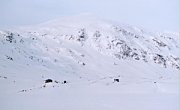
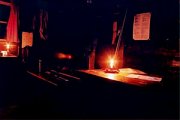 The next morning was beautiful again, -10°, cloudless with a slight breeze.
I had hoped to take a one-day avalanche course before I left, but no-one else
had signed up, and it was cancelled, so I packed up my sled with 20kg of
goodies and put 10kg on my back. Once you have made the decision to pull
a sled, there is no reason to skimp on gear.
The normal route to Kårsavagge is 12km of plodding up 300m in height,
half in birch scrub, half in open valley. It's pleasant enough, but I thought
it would be more fun to take the ski lift up 500m and then traverse down
the side of Slåttatjåkka on "Glidvägen".
I guess I didn't follow the route too well (it wasn't tracked or marked that
early in the season), as my route would better be called "Plummetvägen".
I had been told that the mountain side was 'stepped', so that the track
was mostly flat, but mine was decidedly tilted, which was a problem for my sled until
I repacked it with more weight on the right (upper) side. Then I would find myself
above a 60° slope, and would have to hike back up, or on one occasion
carry my load down in three trips protected by piolet.
By 3pm I wasn't even half way to the cabin,
and I was still high up, and I wondered if I would ever get there.
This wasn't supposed to be an epic, I was supposed to be taking the lazy route.
But by skinning my way back up the mountain I managed to find the summer route
down to the valley, where I launched my sled on her own, and telemarked after her
down to a scooter track that led across the lakes and up to the cabin.
(Examining the moutainside on the trip back, I learned that I had taken
pretty much the worst possible route down - if I had descended sooner or
later I would have had much less trouble, but I chose the rock bands in the middle)
The next morning was beautiful again, -10°, cloudless with a slight breeze.
I had hoped to take a one-day avalanche course before I left, but no-one else
had signed up, and it was cancelled, so I packed up my sled with 20kg of
goodies and put 10kg on my back. Once you have made the decision to pull
a sled, there is no reason to skimp on gear.
The normal route to Kårsavagge is 12km of plodding up 300m in height,
half in birch scrub, half in open valley. It's pleasant enough, but I thought
it would be more fun to take the ski lift up 500m and then traverse down
the side of Slåttatjåkka on "Glidvägen".
I guess I didn't follow the route too well (it wasn't tracked or marked that
early in the season), as my route would better be called "Plummetvägen".
I had been told that the mountain side was 'stepped', so that the track
was mostly flat, but mine was decidedly tilted, which was a problem for my sled until
I repacked it with more weight on the right (upper) side. Then I would find myself
above a 60° slope, and would have to hike back up, or on one occasion
carry my load down in three trips protected by piolet.
By 3pm I wasn't even half way to the cabin,
and I was still high up, and I wondered if I would ever get there.
This wasn't supposed to be an epic, I was supposed to be taking the lazy route.
But by skinning my way back up the mountain I managed to find the summer route
down to the valley, where I launched my sled on her own, and telemarked after her
down to a scooter track that led across the lakes and up to the cabin.
(Examining the moutainside on the trip back, I learned that I had taken
pretty much the worst possible route down - if I had descended sooner or
later I would have had much less trouble, but I chose the rock bands in the middle)
I arrived at the cabin around 5, and expected a quiet doze before fetching water
and sawing logs. Surprise ! There were 13 of us in the 10-bed cabin, 3 couples having
to share the tiny bunk beds, and the effect of 6 dinners cooking and 6 sets of
wet clothes in our 4-bed room was exacerbated by one woman's insistence on continuously
feeding fresh wood into the stove. Luckily I like saunas. I chatted to a nice
young couple from Kiruna, and we all went to bed at 9pm.
I noticed two points of technological progress since my last tour in 1998. On the plus side,
LED headlamps have replaced candle lanterns. They don't give the same cozy light,
but when they give 200 hours of light from two AA cells, it's hard to justify
lugging along lanterns and fuel anymore. Less desirable is that abuse of mobile phones is
now as much of a nuisance in the cabins as it is in town.
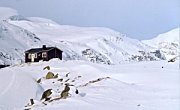
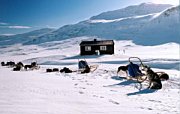 The next morning I hid in my bunk until everyone else had packed up, and then watched
the Kiruna pair head off up the steep pass to Låktatjåkka with
some of the others. They had tiny packs and track skis, and I wondered if I would
ever have the confidence to travel like that. Then I was invited in for
tea and home-made bread by the cabin warden and her husband, Inga-Lisa and Lasse,
who were extremely nice and chatty.
It was fantastic weather again, so my plans for a rest day went out of the window
and up the valley towards the Kårsatjåkka glacier.
It was pleasant, easy tour and I saw a lot of tracks that looked like they were from an arctic fox.
Then there were human tracks leading
up the summer trail west of Kuoblatjårro, and it looked perfect to ski down, but
I was glad I resisted the temptation to go up, as I was flagging a bit as I headed back.
I'm not 25 anymore.
During the day I was surprised at how
many scooters went by, considering they are forbidden. Over my whole stay,
I saw maybe 30 scooters go by that were clearly not on official business.
When I got back there was just time to chop wood and fetch water before dark,
and then settle into my empty cabin. Wheeee !
The next morning I hid in my bunk until everyone else had packed up, and then watched
the Kiruna pair head off up the steep pass to Låktatjåkka with
some of the others. They had tiny packs and track skis, and I wondered if I would
ever have the confidence to travel like that. Then I was invited in for
tea and home-made bread by the cabin warden and her husband, Inga-Lisa and Lasse,
who were extremely nice and chatty.
It was fantastic weather again, so my plans for a rest day went out of the window
and up the valley towards the Kårsatjåkka glacier.
It was pleasant, easy tour and I saw a lot of tracks that looked like they were from an arctic fox.
Then there were human tracks leading
up the summer trail west of Kuoblatjårro, and it looked perfect to ski down, but
I was glad I resisted the temptation to go up, as I was flagging a bit as I headed back.
I'm not 25 anymore.
During the day I was surprised at how
many scooters went by, considering they are forbidden. Over my whole stay,
I saw maybe 30 scooters go by that were clearly not on official business.
When I got back there was just time to chop wood and fetch water before dark,
and then settle into my empty cabin. Wheeee !
As forecast, I awoke to grey skies, +1°C, and 5-8 m/s wind. Not very inspiring.
I pottered around all morning, and was invited again for coffee with the wardens.
Eventually we decided that despite the weather Lasse and I would go on our
planned tour up the summer route towards Låktatjåkka, at least as
far as the lakes, but I suggested that we could consider looping around
Kuoblatjårro if we were still feeling good up there. We left around noon.
I thought that a 70 year old man might be someone that I could keep up with,
and for the first kilometer I did admirably, possibly because I had wide skis with
climbing skins and heel lifters that allowed me to head straight up the 25°+
slope while Lasse had to scissor up on his old wax-free skis. But once we got
on to the flat lakes I was out of my league, and he patiently waited for me every
few minutes. The first lake cascades over into the ravine we came up, facing
us with a 5m wall of ice that we had to climb around, carrying our gear.
I was very glad I didn't have a sled with me.
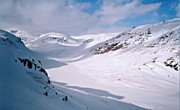
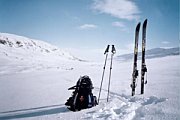 At this point the clouds cleared for a moment and our hard work climbing 300m was rewarded
with a beautiful backlit view of neighbouring mountains. But the next 2km of Latnjajaure
and its runoffs was actually tougher, with a layer of wet snow covering colder, finer snow.
It seemed to be impossible to wax for
the conditions, since the underlayers chilled the red wax needed for
traction on the wet snow until it was so cold that it iced up. Using skins didn't help, and
the light was also so flat that we
couldn't see the texture of the snow at our feet.
I was all for turning around at this point, but Lasse was now enthusiastic about my loop,
so I said nothing and plodded uncomfortably behind as he zoomed up Latnjavagge.
This was another 20° slope that gained us 200m in height, and at the top of
it I was still keen on turning around as the telemarking down would be fairly
easy even in the awkward snow,
and we would be spared the 6km flat at the end of the loop route.
But before I had time to mention this, Lasse had already headed into 'Halpasset',
and I followed him down.
From here I could see the camp on the Kuoblaglacier where we had spent a
horrible night in an August snowstorm a couple of years before
(story).
It didn't look so different in March. Lasse confidently led the way towards
our 4km long gentle slope down, but something seemed wrong.
By the time I had caught him up and checked the map,
we were commited to the summer route on the wrong side of Kuoblatjårro,
the one that we had both decided was far too steep, rocky and scary to consider.
Also, it was still flat light and hard to see the snow surface.
We went for it anyway, and Lasse said "We should keep apart in case one of us
falls down a ravine. Would you like to go first ?". Perhaps I look dispensible,
but hopefully it was just that I had better downhill skis and eyesight.
I put both to good use by stopping 1m from a rather ugly drop into a rocky ravine.
We headed up again and found the cairns marking the summer route down. I remembered
this as horribly steep and uneven on foot and as we traversed down to it
I grew very apprehensive because I couldn't see the rest of the slope down
as the ground curved away and appeared to simply plummet to the valley floor
400m below. Looking at the steep rocky cliffs on the other side didn't
inspire confidence either.
The thought that we should at least be able to walk down the summer track carrying our skis
kept me going, even though that wasn't necessarily true because of possible avalanche danger,
deep snow, or ice (I remembered the route directly following a stream).
I would never have attempted this alone, although it wasn't clear how being two would help if we got stuck here.
At this point the clouds cleared for a moment and our hard work climbing 300m was rewarded
with a beautiful backlit view of neighbouring mountains. But the next 2km of Latnjajaure
and its runoffs was actually tougher, with a layer of wet snow covering colder, finer snow.
It seemed to be impossible to wax for
the conditions, since the underlayers chilled the red wax needed for
traction on the wet snow until it was so cold that it iced up. Using skins didn't help, and
the light was also so flat that we
couldn't see the texture of the snow at our feet.
I was all for turning around at this point, but Lasse was now enthusiastic about my loop,
so I said nothing and plodded uncomfortably behind as he zoomed up Latnjavagge.
This was another 20° slope that gained us 200m in height, and at the top of
it I was still keen on turning around as the telemarking down would be fairly
easy even in the awkward snow,
and we would be spared the 6km flat at the end of the loop route.
But before I had time to mention this, Lasse had already headed into 'Halpasset',
and I followed him down.
From here I could see the camp on the Kuoblaglacier where we had spent a
horrible night in an August snowstorm a couple of years before
(story).
It didn't look so different in March. Lasse confidently led the way towards
our 4km long gentle slope down, but something seemed wrong.
By the time I had caught him up and checked the map,
we were commited to the summer route on the wrong side of Kuoblatjårro,
the one that we had both decided was far too steep, rocky and scary to consider.
Also, it was still flat light and hard to see the snow surface.
We went for it anyway, and Lasse said "We should keep apart in case one of us
falls down a ravine. Would you like to go first ?". Perhaps I look dispensible,
but hopefully it was just that I had better downhill skis and eyesight.
I put both to good use by stopping 1m from a rather ugly drop into a rocky ravine.
We headed up again and found the cairns marking the summer route down. I remembered
this as horribly steep and uneven on foot and as we traversed down to it
I grew very apprehensive because I couldn't see the rest of the slope down
as the ground curved away and appeared to simply plummet to the valley floor
400m below. Looking at the steep rocky cliffs on the other side didn't
inspire confidence either.
The thought that we should at least be able to walk down the summer track carrying our skis
kept me going, even though that wasn't necessarily true because of possible avalanche danger,
deep snow, or ice (I remembered the route directly following a stream).
I would never have attempted this alone, although it wasn't clear how being two would help if we got stuck here.
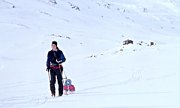
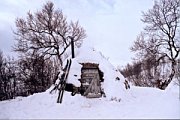 Still, Lasse was stronger and more experienced than I was, so that added to the equation.
Eventually we found a fairly clear 30° slope about 30m wide that we could
traverse back and forth to get down.
There didn't seem to be any avalanche danger (a lot of rocks sticking through),
but the snow quality varied from sugar to wet cement to dry cement, and in the flat light
I only knew about the transitions when I felt sugar, wet cement or dry cement being forced
into my eyes, nose and mouth.
It was a painful journey down, made all the worse by the realisation that
our 4 hour stuggle upwards should have been rewarded by a fun run home.
The consolation was that the bad snow and light would have spoiled it anyway.
As smart readers will have deduced, we made it home safely after another hour
along the valley floor. Given the weather, it was a good tour to have done,
and fun to do it with Lasse. Amazingly, we had a following wind the whole way,
and I could have used my traction kite on the way home.
Inga-Lisa then cooked us a huge and wonderful pea soup, which we spent the evening devouring,
before I headed back to the still empty stuga.
Still, Lasse was stronger and more experienced than I was, so that added to the equation.
Eventually we found a fairly clear 30° slope about 30m wide that we could
traverse back and forth to get down.
There didn't seem to be any avalanche danger (a lot of rocks sticking through),
but the snow quality varied from sugar to wet cement to dry cement, and in the flat light
I only knew about the transitions when I felt sugar, wet cement or dry cement being forced
into my eyes, nose and mouth.
It was a painful journey down, made all the worse by the realisation that
our 4 hour stuggle upwards should have been rewarded by a fun run home.
The consolation was that the bad snow and light would have spoiled it anyway.
As smart readers will have deduced, we made it home safely after another hour
along the valley floor. Given the weather, it was a good tour to have done,
and fun to do it with Lasse. Amazingly, we had a following wind the whole way,
and I could have used my traction kite on the way home.
Inga-Lisa then cooked us a huge and wonderful pea soup, which we spent the evening devouring,
before I headed back to the still empty stuga.
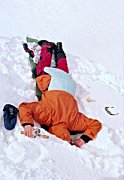
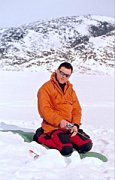 I slept surprisigly badly that night, perhaps because the adrenaline/exercise
ratio had been a bit too high. I felt distracted and unmotivated, and the weather was
grey again, +1°C with a 10 m/s wind (which built to 20 by the evening).
I had my now routine coffee and chat with the wardens, and then took a short
trip up the south side of the valley.
It took an hour to traverse up 400m over 2 km, on a 20° to 30° slope.
Some of the steeper slopes looked kind of avalanchey, so I dug a pit to look
for weak layers and found none down to 1m. If there was going to be a slide,
it would be a big one, but I felt comfortable that they were stable.
The last 100m up to the saddle between Boazutjåkka and peak 1223 were very steep
and hard, so I cached my skis and hiked up with piolet in hand.
I should probably have gone for peak 1223, but this was supposed to be a rest day,
and I knew that it wouldn't be as trivial as it looked from the saddle.
Instead I had a tea break behind a big rock that protected me from the ghastly wind
and spin-drift coming though the saddle.
Then I glissaded back to my skis and had a quick and effortless glide back to the cabin.
Determined to save my strength for the following day, I then took advantage of
the wardens being out on a ski tour and went ice fishing in the water hole
(you need a permit to fish, which I didn't have).
I caught two small perch-like fish that I let go again. No big, juicy char for dinner.
Back at the cabin I disturbed a mouse rummaging through my things, which
at least explained the hole in my cheese bag.
I slept surprisigly badly that night, perhaps because the adrenaline/exercise
ratio had been a bit too high. I felt distracted and unmotivated, and the weather was
grey again, +1°C with a 10 m/s wind (which built to 20 by the evening).
I had my now routine coffee and chat with the wardens, and then took a short
trip up the south side of the valley.
It took an hour to traverse up 400m over 2 km, on a 20° to 30° slope.
Some of the steeper slopes looked kind of avalanchey, so I dug a pit to look
for weak layers and found none down to 1m. If there was going to be a slide,
it would be a big one, but I felt comfortable that they were stable.
The last 100m up to the saddle between Boazutjåkka and peak 1223 were very steep
and hard, so I cached my skis and hiked up with piolet in hand.
I should probably have gone for peak 1223, but this was supposed to be a rest day,
and I knew that it wouldn't be as trivial as it looked from the saddle.
Instead I had a tea break behind a big rock that protected me from the ghastly wind
and spin-drift coming though the saddle.
Then I glissaded back to my skis and had a quick and effortless glide back to the cabin.
Determined to save my strength for the following day, I then took advantage of
the wardens being out on a ski tour and went ice fishing in the water hole
(you need a permit to fish, which I didn't have).
I caught two small perch-like fish that I let go again. No big, juicy char for dinner.
Back at the cabin I disturbed a mouse rummaging through my things, which
at least explained the hole in my cheese bag.
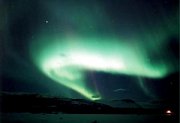
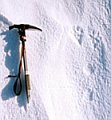 Time to head back to Abisko. I got up at 7am to more cloud, +1°C and a 20m/s
westerly wind. Ugh.
My worst fear was that my skis would ice up again and I would make very slow progress,
but that turned out not to be a problem, perhaps because the snow had now
equilibrated in temperature.
The gale-force wind was directly behind me, and as I trudged across the lakes
I desperately wished that I'd brought my traction kite along. It only weighs
300g, but I had thrown in too many 300g toys, and the probability that I would
get these perfect conditions to use it had been pretty low.
Above tree line the wind was too strong to stop and rest, so it was 3 hours before my
first break, at a cute little reindeer herder's hut.
After that it was a bit of a roller coaster ride through the birches down to the fjällstation.
Nothing too difficult, but there were downhill stretches that I had to take a lot faster than I would
have chosen so as not to upset my sled by braking suddenly on a curve.
By the time I got down, the wind had disappeared completely and it was +5°C and sunny.
I washed some of my clothes, showered and shaved, and then dozed in front
of the fire in the lounge, disturbed only by a photographer who wanted me to
pretend to be a guest dozing in front of the fire for an advertising photo.
I must have been brilliant.
Time to head back to Abisko. I got up at 7am to more cloud, +1°C and a 20m/s
westerly wind. Ugh.
My worst fear was that my skis would ice up again and I would make very slow progress,
but that turned out not to be a problem, perhaps because the snow had now
equilibrated in temperature.
The gale-force wind was directly behind me, and as I trudged across the lakes
I desperately wished that I'd brought my traction kite along. It only weighs
300g, but I had thrown in too many 300g toys, and the probability that I would
get these perfect conditions to use it had been pretty low.
Above tree line the wind was too strong to stop and rest, so it was 3 hours before my
first break, at a cute little reindeer herder's hut.
After that it was a bit of a roller coaster ride through the birches down to the fjällstation.
Nothing too difficult, but there were downhill stretches that I had to take a lot faster than I would
have chosen so as not to upset my sled by braking suddenly on a curve.
By the time I got down, the wind had disappeared completely and it was +5°C and sunny.
I washed some of my clothes, showered and shaved, and then dozed in front
of the fire in the lounge, disturbed only by a photographer who wanted me to
pretend to be a guest dozing in front of the fire for an advertising photo.
I must have been brilliant.
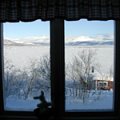
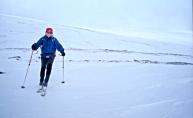 The rest of my stay up north was spent in Anders' and Åsa's cabin
in Stenbacken, half way between Abisko and Kiruna. There was more ice fishing,
a day trip up Kaisepakte, lots of saunas, northern lights, some wolverine tracks up on Piesketjåkka, and brilliant downhill skiing at Björkliden and Riksgränsen.
I tried again to get on an avalanche course at Abisko, and there was still no interest,
but the same day a 200m wide grade 3 avalanche occured on Nuojla, so maybe the next day
there was more interest. Grade 3 apparently means severe enough to crush a car, but 30 people searching
for several hours found no-one buried, and no-one was reported missing.
The rest of my stay up north was spent in Anders' and Åsa's cabin
in Stenbacken, half way between Abisko and Kiruna. There was more ice fishing,
a day trip up Kaisepakte, lots of saunas, northern lights, some wolverine tracks up on Piesketjåkka, and brilliant downhill skiing at Björkliden and Riksgränsen.
I tried again to get on an avalanche course at Abisko, and there was still no interest,
but the same day a 200m wide grade 3 avalanche occured on Nuojla, so maybe the next day
there was more interest. Grade 3 apparently means severe enough to crush a car, but 30 people searching
for several hours found no-one buried, and no-one was reported missing.
All in all it was a good, varied trip, despite poor planning. I can recommend Kårsavagge
as a base for a short trip, or as an introduction to cabin touring before doing something more ambitious.
© Mark Harris 2002
(Back to ski report index)
(MRH homepage)

 I arrived in Abisko to a beautiful, still, cloudless day at -5°C, and
after dumping my packs in my room I headed straight for the house
ski slope, Nuolja. Actually, it's just a lift, which deposits you on the
ungroomed face of the mountain, 500m above the fjällstation.
Because I was planning mostly top-tours, I had left my regular tour skis
at home, and was on Tua Cirques, which have a soft camber and a distinct waist,
and I wore heavier leather boots with double straps.
This was a great combination for telemarking down Nuolja's offpiste, which
was hard packed with about an inch of loose fresh snow on top. Perfect.
Despite putting in my best tele performance ever, things are always relative,
and so I stuck to the easy slope that starts at about 20° and increases
to 30° before entering the dwarf birch forest half way back to the lift.
There is a lift pickup above tree line, which would save the time and energy
spent on the rather tedious and rough trail down below, but only staff
are allowed to use it. Farther away from the lift are more challenging
slopes with ravines and drops and avalanches and scary stuff like that, which I avoided but still
spent 3 hours having immense fun before realising that I should probably
save some of my completely untrained legs for the next day.
I arrived in Abisko to a beautiful, still, cloudless day at -5°C, and
after dumping my packs in my room I headed straight for the house
ski slope, Nuolja. Actually, it's just a lift, which deposits you on the
ungroomed face of the mountain, 500m above the fjällstation.
Because I was planning mostly top-tours, I had left my regular tour skis
at home, and was on Tua Cirques, which have a soft camber and a distinct waist,
and I wore heavier leather boots with double straps.
This was a great combination for telemarking down Nuolja's offpiste, which
was hard packed with about an inch of loose fresh snow on top. Perfect.
Despite putting in my best tele performance ever, things are always relative,
and so I stuck to the easy slope that starts at about 20° and increases
to 30° before entering the dwarf birch forest half way back to the lift.
There is a lift pickup above tree line, which would save the time and energy
spent on the rather tedious and rough trail down below, but only staff
are allowed to use it. Farther away from the lift are more challenging
slopes with ravines and drops and avalanches and scary stuff like that, which I avoided but still
spent 3 hours having immense fun before realising that I should probably
save some of my completely untrained legs for the next day.













